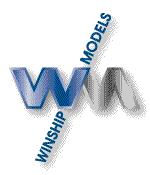This page is not intended to cover the whole process of
building this kit but to highlight some of the construction features along
the way.
I have decided to power this 80" Extra 300 with a Moki 2.10. Radio
will be a Futaba 8 channel. I decided to build this airplane instead of
the Hostetler Edge 540 at this time. The Edge 540 will come next.
Midwest has done a great job of engineering this kit along with high
quality materials and great customer service. When the box arrived from
Chief Aircraft via. UPS in perfect condition with a dented canopy I
emailed Midwest and stated that I had the kit without any box damage but
the contents must have shifted and dented the canopy. I mentioned that I
was willing to purchase another canopy but they said one was on its way
free of charge. A few days later it was on my doorstep. Thank you Midwest!
The new Extra 300 kit comes with a laser cut horizontal stab ribs along
with laser cut parts for the vertical stab and rudder. This new stab in my
opinion is stronger and looks better on this model. I am in the process of
making a carbon fiber landing gear for this model and will construct a
plug and mold for the cowling and wheel pants which will be featured
on this web page.
